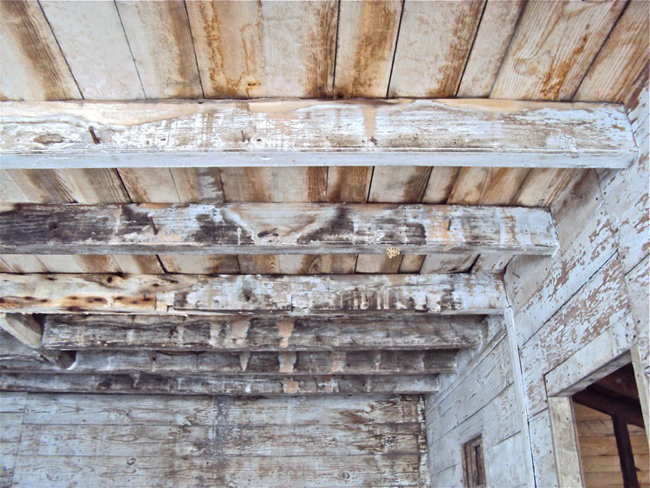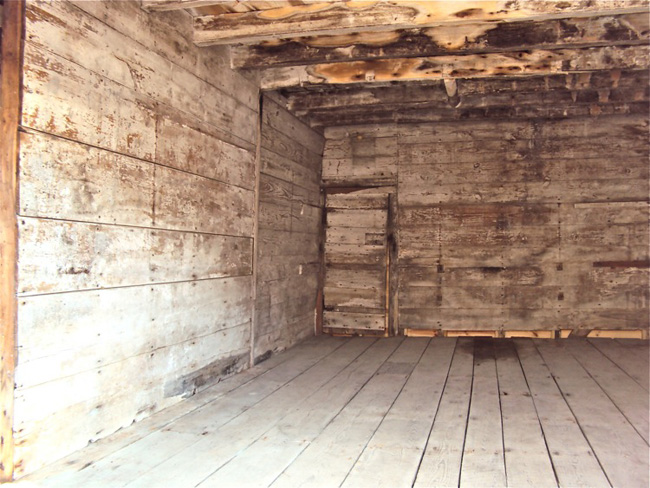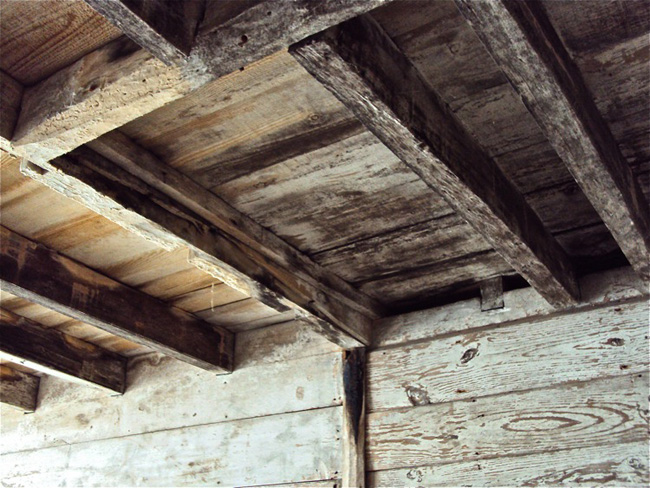Architectural Information
Architectural Description - Interior
Floor Plan
The original 15' by 25' store was divided into two rooms by a partition wall. The larger of the two rooms, currently on the southern end of the building, was the retail room. It was connected to the smaller northern counting room by an interior doorway near the center of the partition wall. The location of the partition wall can be seen in the joist above the vanished wall. Two sets of bevel lap mortise, originally used for setting the studs of the partition wall, are evident in the joist. The spacing of the mortise, and thus the studs, indicates the width of the partition doorway between the retail and counting rooms. One set of laps is later than the other, cutting partly into the earlier set. Upon inspection, Mark Wenger suggested that it is possible only the later set was used to set the partition studs.
The store's main entrance on the east elevation, as well as a freight loading door on the south elevation, opened into the retail room. A single exit door from the counting room was located in the northwest corner of the room. A staircase to the store's attic was located in the southwest corner of the counting room, against the wall partition. The staircase was removed sometime in the nineteenth century, and it is uncertain whether it was a conventional wooden stair, or a simpler ladder stair. Mark Wenger recommends removing the sheathing on the upper west wall of the counting room where the stair rose to the attic. The presence of nails or nail holes for winders or a landing would indicate that a conventional staircase was used.[i] The attic space of the building was a single unfinished room over the same footprint as the ground floor.
The east and west shed roof additions are each a single room, presumably added onto the building for extra storage. The east wing accesses the original retail room by the original east elevation double-leaf front door, as well as a single doorway that was originally a window. The west wing had no interior access to the original store until 2010, when later boards in the southwest corner of the old store were removed.
[i] Wenger, pp.3-4.
Wall and Ceiling Finish
The wall and ceiling finishes in the retail room differ from those in the counting room, due to the likelihood that the counting room was intended to be finished with plaster. This is common among early stores; the counting room would have been the more nicely finished of the two rooms, while the retail room would have been simply sheathed to simplify wall shelving.
In the retail room, the walls retain a lime-washed finish. They are sheathed with wide horizontal boards that are planed on their outer face and have a narrow beaded edge. The exposed ceiling joists are planed and beaded, and the underside of the flooring above was also planed smooth. This is an indication that the ceiling was meant to be exposed from the time of construction.
Beaded ceiling joists of retail room and unplaned joists in counting room, showing salt efflorescence
Original back wall of retail room, showing traces of shelves and brackets.
The ceiling surface - and the ceiling joists - of both rooms evidences a thick, soft coating resulting from salt efflorescence. It is more visible at the south end of the building. It results from salted hams being hung to cure in the attic (nails are visible, neatly spaced, on each of the collar ties between the rafters of the roof). Salt was also probably stored there.The floor of the attic was thickly coated with residue, most of which was removed during the recent preservation efforts.
The counting room walls are covered in horizontal bevel-edged board sheathing, dating to a remodeling that likely occurred in the third quarter of the nineteenth century.[i] This sheathing predates the removal of the partition wall between the counting and retail rooms, as it stops at the vanished wall. The void in wall covering left when the partition was removed was covered with a beveled board. The counting room is trimmed out to be plastered, with an original base board, beaded chair board, and window trim. The hewn and pit-sawn ceiling joists were left unplaned, and the flooring above was gauged and undercut rather than smooth finished, indicating that the ceiling was to be covered in plaster as well. However, though the room was obviously intended to be plastered, it does not appear that plaster was ever actually applied. An inspection behind the sheathing on the north wall produced no sign of plaster. The bevel-edged sheathing appears to be the only finish ever applied to the counting room walls. Since the sheathing on the north wall may be later than that on the east and west walls because it covers the opening where the chimney once stood, Mark Wenger recommends examining beneath the sheathing on the adjoining east wall to be certain that none of the counting room walls were ever plastered.[ii]
Ceiling joists of counting room showing original stair opening to the attic and original location of wall dividing the two rooms
The interior of both rooms were covered in a lime-wash at some point, most likely when the interior partition was removed, as the finish was applied over the beveled board that covers the gap left by the wall. It is certainly not original in the counting room; when the present exterior siding was installed over the counting room door, a cleat was nailed over the top edge of the door to fasten it shut. Subsequently, this cleat split horizontally, revealing that there is no lime-wash underneath (see illustration of north wall door above). The finish was therefore not applied to the wall until after the new siding was installed.
Both the retail room and the counting room were at one time shelved to display goods and for storage, and ghosts for the shelving can still be seen on the sheathing of the east, west, and north walls; the interior sheathing on the south wall has been removed. (See illustration above – "Original back wall of retail room…") The ghosts on the west wall, opposite the main entrance, are likely from the original shelving, as this is where the retail counter would have stood with display shelving behind. Two of the shelves, located approximately 33" and 60" above the floor, were supported with either ogee brackets or a straight stanchion two-nailed to the wall sheathing from both sides. The west wall shelving continues into the counting room, where it is likely a later extension of the original retail room shelving; there is a ghost of a shelf edge on the counting room door, indicating that the shelf was installed after the door was secured shut. This ghost shows a shelf of approximately 18" deep, which may have also been the depth of the retail room shelving.
The shelving on the east wall of the store also seems to be a later addition, which is in keeping with the main entrance being on the (current) east wall, and therefore the unshelved public area of the retail room. The ghosts for the east wall shelving span the beveled board installed to cover the gap when the partition wall was removed, so at least this section of shelving, if not all of the east wall shelving, was installed after the partition's removal. A finish of lime-wash was applied after the installation of the shelving, as the ghosts are present with an outline of the finish.[iii]
[i] Graham, p.2.
[ii] Wenger, pp.2-3.
[iii] Wenger, pp.4-5.
Flooring
Although the flooring on the ground floor of the store was replaced in the twentieth century, the attic flooring is original. It was gauged and undercut above the counting room, and planed smooth on its lower face above the retail room. Gauged and undercut floors are far more typical in the eighteenth and early nineteenth centuries, but by 1820 flooring of consistent thickness had become more common. Still, it is not unheard of for a pre-1820 buildingto have flooring that was not undercut when the lower face of that flooring was intended to be exposed rather than plastered. In other similar examples of exposed joist ceilings, the underside of the flooring was often plane in the Thomas James Store to give the boards an even thickness and a more decorative appearance.[iv]
[iv] Graham, p.4.
Works Cited
- Atherton, Lewis A. The Southern Country Store, 1800-1860. Baton Rouge: Louisiana State University Press, 1949.
- Bradley, Stephen E., Jr. Mathews County Virginia, Censuses 1810, 1820, 1830, 1840. Self-published, 1992.
- Deed of sale from Commissioners of the Circuit Court to William N. Trader and John W. Dixon, Jr., 1893, Deed Book 10, page 403, Mathews County Clerk’s Office, Mathews, VA.
- Deed of sale from F. Joseph Sibley to Cecil Sibley, 1945, Deed Book 40, page 361, Mathews County Clerk’s Office, Mathews, VA.
- Deed of sale from Helen Miller Sibley to Cecil Sibley, 1948, Deed Book 43, page 288, Mathews County Clerk’s Office, Mathews, VA.
- Deed of sale from Jerry Fruehbrodt to Michael J. Brown, 2003, Deed Book 295, page 299, Mathews County Clerk’s Office, Mathews, VA.
- Deed of sale from John W. Dixon, Jr. to William N. Trader, 1899, Deed Book 12, page 193, Mathews County Clerk’s Office, Mathews, VA.
- Deed of sale from Mary Sibley to Jerry Fruehbrodt, 1989, Deed Book 148, page 812, Mathews County Clerk’s Office, Mathews, VA.
- Deed of sale from William Trader to Henry and F. Joseph Sibley, 1899, Deed Book 12, page 231, Mathews County Clerk’s Office, Mathews, VA.
- Federal Census of 1850, Mathews County Virginia.
- Graham, Willie. “Sibley Store: Mathews Courthouse, VA.” Unpublished report, March 3, 2006.
- Land Tax Records, 1807-1819. Mathews County Courthouse, Mathews, VA.
- Land Tax Records, 1815-1820. Mathews County Courthouse, Mathews, VA.
- Land Tax Records, 1820-1846. Mathews County Courthouse, Mathews, VA.
- Land Tax Records, 1846-1872. Mathews County Courthouse, Mathews, VA.
- Land Tax Records, 1898. Mathews County Courthouse, Mathews, VA.
- Land Tax Records, 1900. Mathews County Courthouse, Mathews, VA.
- Lounsbury, Carl L. An Illustrated Glossary of Early Southern Architecture & Landscape. New York: Oxford University Press, 1994.
- Martin, Joseph, ed. A New and Comprehensive Gazetteer of Virginia and the District of Columbia. Westminster, MD: WIllow Bend Books, 2000.
- Mason, Polly Cary. Records of Colonial Gloucester County Virginia, Volume I.
- Matheny, Emma R., and Helen K. Yates, ed. Kingston Parish Register Gloucester and Mathews Counties 1749-1827.
Mathews County Commissioner of the Revenue. Property Card, Parcel 26A3-A-107. County of Mathews, VA. http://www.emapsplus.com/vamathews/maps (accessed November 6, 2008).
- Mathews County Historical Society. History and Progress: Mathews County, Virginia. Mathews County, Virginia: Mathews County Historical Society, 1982.
- Mathews County Virginia Executors’ Bonds, 1795-1825, and Guardian Bonds, Book B, 1806-1822.
- Mathews County Visitor and Information Center. “Mathews History and Statistics.” Mathews County Visitor and Information Center. http://www.visitmathewsva.com/statistics.html (accessed October 25, 2008).
- Receipt dated May 30, 1810. Richard Billups papers. Box 4, Folder 1. Swem Library, College of William & Mary, Williamsburg, VA.
- Wenger, Mark. “Thomas James Store – Matthews (sic), Virginia.” Report, 27 November 2008.
- Will of Cecil Sibley, 1987, Will Book 17, page 537, Mathews County Clerk’s Office, Mathews, VA.


